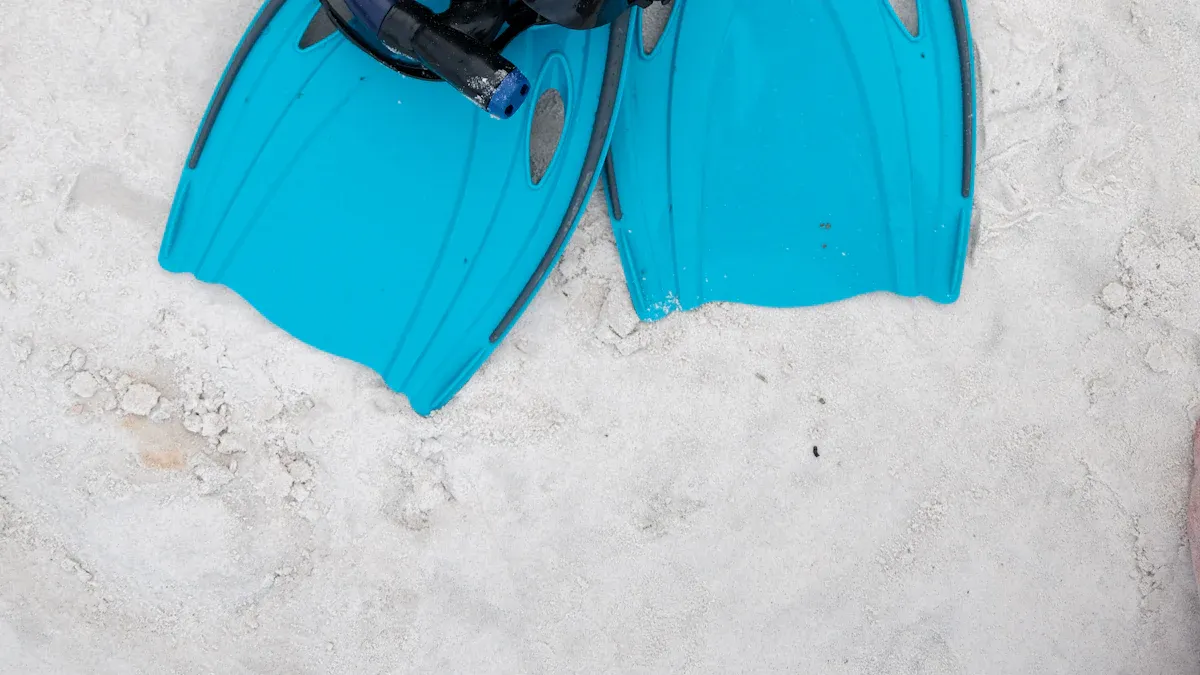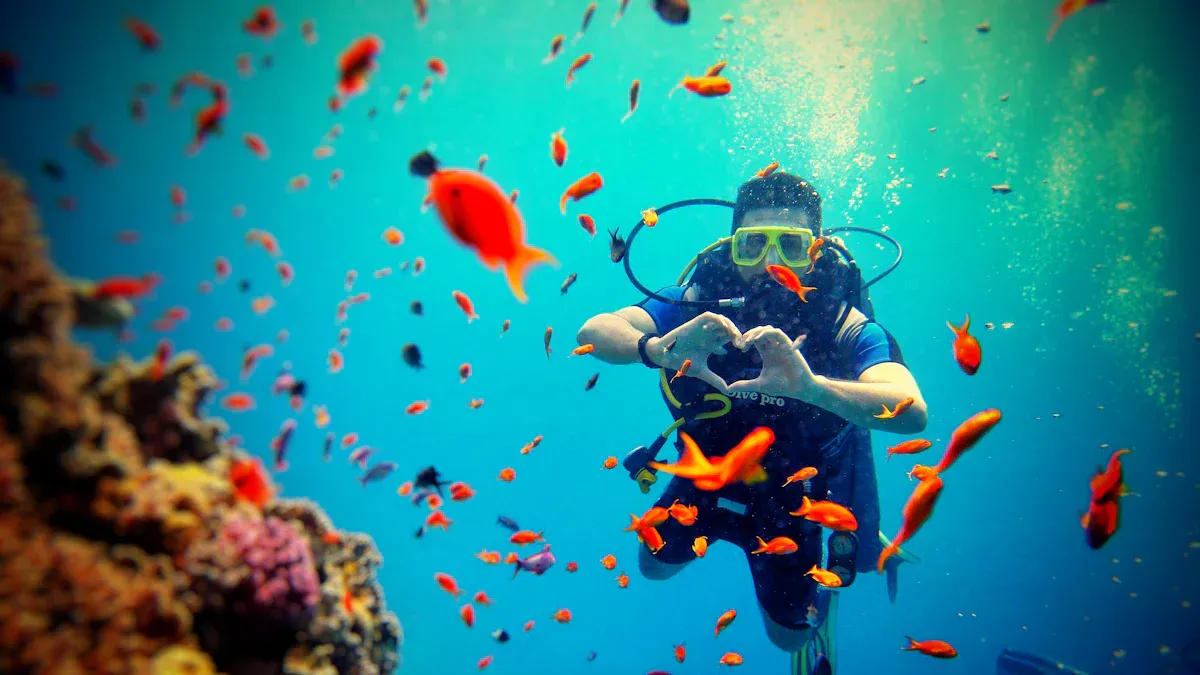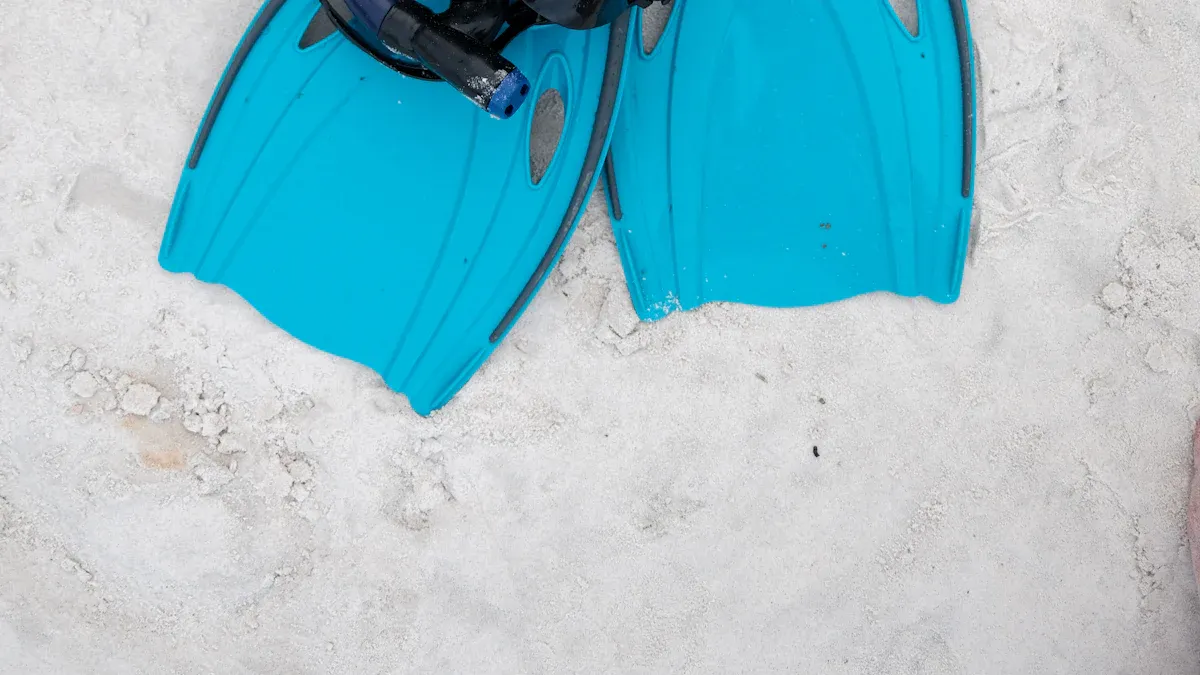
Choosing the right diving fins can make your underwater adventure smoother and more enjoyable. You want fins that match your style and feel comfortable on your feet. The right pair depends on where you dive and how strong your legs are. Some fins work better in calm water, while others help you move through strong currents. If your fins fit well, you swim easier and stay safe. Focus on what feels good and works for you from the start.
Pick fins that match how you dive. Scuba diving, freediving, and snorkeling each need special fins. These fins help you do your best in the water.
Fit and comfort are very important. Fins should fit snugly to stop blisters and tired feet. Always try on fins before you buy them. Make sure they feel good on your feet.
Think about the water you will dive in. Paddle fins work well in calm water. Jet fins are better for strong currents. The right fins make diving easier and more fun.
Look at what the fins are made of and how much they weigh. Lighter fins are simple to pack and carry. Heavier fins give you more power but can make your legs tired faster.
Take care of your fins the right way. Rinse them after every dive. Store them properly to help them last longer and work better.

You have many ways to enjoy the water, and each activity needs the right gear. When you pick diving fins, think about what you plan to do most. Here are some common activities that need special fins:
Scuba diving
Freediving
Snorkeling
Body surfing
If you love recreational diving or just want to explore, bi-fins work well. They feel agile and easy for beginners. You should look for fins that match your strength and skill. For freediving, lightweight and flexible fins help you move with less effort. If you want more power and precision, stiffer fins give you strong thrust. These work best for technical dives or when you need to move fast.
Tip: Comfort matters! Lightweight fins make long swims easier and keep your legs from getting tired.
Water changes everything. Calm water lets you use basic paddle fins. These are solid and reliable. If you dive in strong currents, jet fins give you more power and last longer. For long dives, split fins help save energy and reduce leg fatigue. Check out this table to see how different fins work in different water:
|
Fin Design |
Water Conditions Impacted |
Pros |
Cons |
|---|---|---|---|
|
Paddle Fins |
Tranquil waters |
Basic and solid, reliable |
More effort needed in heavy currents |
|
Split Fins |
Long dives |
Energy-efficient, reduces leg fatigue |
Less powerful in strong currents |
|
Jet Fins |
Strong currents |
Great performance, durable |
Heavier compared to other designs |
If you travel or dive only sometimes, you want fins that are easy to pack and carry. Choose diving fins that feel snug but not tight. Adjustable straps and soft foot pockets help you get a good fit. Lightweight and compact fins make it easy to move, even in tight spaces. Some fins use eco-friendly materials, which is great if you care about the ocean. Good maneuverability helps you enjoy your dive, even if you do not dive often.

When you start looking for diving fins, you’ll notice there are many types out there. Each type has its own features, so you can find the best fit for your next adventure. If you want to see a wide range of options or learn more, check out DG Wonderful Sportz for helpful info and great choices.
You’ll see two main styles: open-heel and full-foot fins. Here’s how they compare:
Open-heel fins have an adjustable strap at the back. You wear them with dive booties, which keeps your feet warm in cold water. These fins work well in different water temperatures. They cost more and feel a bit heavier, but you get a snug fit and extra protection.
Full-foot fins slip right onto your bare feet. They’re lighter, cheaper, and easy to pack. These fins feel best in warm, calm waters. You don’t need booties, but you get less foot protection on rocky shores.
Tip: If you dive in both warm and cold places, open-heel fins give you more flexibility.
Blade style changes how you move in the water. You can pick from long or short blades, and each has its own strengths.
|
Type of Fin |
Advantages |
Disadvantages |
|---|---|---|
|
Long Blade |
Strong kicks, great for freediving and strong currents, helps with muscle strength |
Harder to turn quickly, not great for fast moves |
|
Short Blade |
Easy to kick, good for shallow water and quick turns |
Less power for deep dives, legs may get tired faster |
Some diving fins have split or vented blades. Split fins help you kick with less effort, while vented fins keep sand and silt from stirring up.
Every fin style has ups and downs. Here’s a quick look:
Standard fins: Simple and sturdy, but not always the most powerful.
Vented fins: Great for cave diving, keep the water clear.
Channel fins: Flexible, easy on your legs, push more water.
Split fins: Less drag, easy to kick, but not as strong in currents.
Hinged fins: Give you power with less work, good for many dive spots.
Freediving fins: Long blades, perfect for underwater hunting and deep dives.
If you want to match your fin to your dive, think about where you’ll go and how you like to swim. The right diving fins make every trip better!
You want your diving fins to feel good from the moment you slip them on. A proper fit keeps your feet comfortable and helps you move smoothly underwater. If your fins are too loose, they rub and cause blisters. If they are too tight, your feet get sore fast. Look for foot pockets that hug your feet without squeezing. Adjustable straps and quick-release buckles make it easy to get the right fit. Here’s what you should keep in mind:
A snug fit prevents blisters and keeps your energy up.
High-quality fins reduce fatigue and make long dives more enjoyable.
Full-foot fins should match your shoe size. Open-heel fins work best when you size up for booties.
Always check the sizing chart before you buy.
Tip: Try your fins on before you head out. Walk around a bit to see if they pinch or slip.
The size and weight of your diving fins matter, especially if you travel or dive often. Lighter fins are easier to pack and carry. Heavy fins give you more power but can tire your legs faster. Here’s a quick look at popular models and their weights:
|
Diving Fin Model |
Weight (lb) |
Weight (kg) |
|---|---|---|
|
Tusa X-Pert Evolution |
2.3 |
1.0 |
|
Oceanic Vertex V6 |
2.4 |
1.1 |
|
Scubapro Go Travel |
2.8 |
1.6 |
|
Mares X Stream |
3.5 |
1.6 |
|
Scubapro Seawing Nova |
3.75 |
1.7 |
|
Mares Volo Power |
3.8 |
1.72 |
|
Hollis F2 |
3.96 |
1.8 |
|
Atomic Split Fins |
5.02 |
2.28 |
|
Scubapro Jet Fins |
6.8 |
3.08 |
|
Hollis F1 |
7.6 |
3.46 |

If you travel a lot, choose fins that are light and easy to pack. If you want more thrust, heavier fins might be better for you.
Stiffness and flexibility change how you swim and how much energy you use. Medium stiffness fins give you the best mix of power and comfort. Highly flexible fins bend easily but can make you work harder. Rigid fins push more water but use up your energy quickly. Some fins combine both, so you get strong kicks without getting tired.
|
Fin Type |
Performance Impact |
Energy Expenditure Impact |
|---|---|---|
|
Medium Stiffness Fins |
Good for propulsion |
Saves energy |
|
Highly Flexible Fins |
May lose thrust during kicks |
Uses more energy |
|
Truefin |
Mixes rigidity and flexibility, less muscle fatigue |
Moves efficiently, saves energy |
|
Traditional Flexible Fins |
Works well for slow swimming |
Economical at slow speeds |
|
Rigid Fins |
Can waste energy, not always more powerful |
Uses up energy faster |
Note: If you have strong legs and want speed, stiffer fins work well. If you prefer easy kicks, flexible fins are better.
Straps keep your diving fins secure. You want straps that adjust easily and stay put. Some fins use bungee straps, which stretch and fit snugly. Others have quick-release buckles for fast changes. Look for soft heel pads and large pull tabs. These make it easy to put your fins on and take them off, even with gloves.
|
Strap Mechanism |
Description |
|---|---|
|
Bungee Strap |
Elastic, self-adjusting, soft heel pad, easy to put on and take off |
|
Replaceable Bungee Heel Strap |
Versatile fit, comfortable, good power transfer |
|
Adjustable Strap with Quick Release Buckle |
Large pull tab, quick to adjust |
|
TUSA Anatomic Fin Strap (AFS) |
Patented, easy adjustment, secure fit |
|
Patented Bungee Fin Strap |
Elastic cord, fits well with booties |
Tip: If you dive in cold water, choose straps that work with thick booties.
Buoyancy affects how you float and move underwater. Heavy fins can pull your legs down, making it hard to stay flat. Lighter fins help you keep a good trim and balance. The right buoyancy lets you glide smoothly and control your movement.
Materials change how your fins perform and last. Rubber fins are flexible and last a long time. Plastic fins are light and good for beginners. Carbon fiber and composite materials make fins strong and stiff, perfect for powerful kicks. Some new fibers, like Innegra, resist impact and do not wear out quickly.
|
Material |
Stiffness Level |
Key Features |
|---|---|---|
|
Composite Fiber |
Medium |
Durable, reduces fatigue, good maneuverability |
|
Carbon Fiber |
High |
Lightweight, strong, powerful kicks |
|
HypeTex Fiber |
Higher |
Very stiff, light, efficient propulsion |
|
Innegra Fiber |
Highest |
Impact resistant, flexible, lightweight, resists chemicals |
|
Material |
Lifespan |
|---|---|
|
Carbon composite blades |
5-7 years |
|
Molded thermoplastic |
Over a decade |
|
Vulcanized rubber |
Over a decade |
Note: If you want fins that last, choose rubber or molded thermoplastic. If you want top performance, try carbon fiber or composite fins.
Ready to find your perfect pair? Check out the latest diving fins at DG Wonderful Sportz for more options and expert advice.
You want your fins to work with the water, not against it. Different conditions call for different choices. Here are some tips from experienced divers:
Pick closed-heel fins if you dive in cold water. They keep your feet warm and safe.
Use stiff fins when you swim in strong currents. They give you more power with each kick.
Try technical fins for wreck or cave diving. Their smaller size helps you move in tight spaces.
Think about your kicking style. Flexible fins work well for flutter or scull kicks. Technical fins support advanced moves.
Tip: Always match your fins to the water and your own swimming style. This makes every dive easier and more fun.
You should always try on fins before you buy them. Fit matters more than anything else.
The foot pocket should be snug all over without any movement. If you move your foot vertically or laterally, your foot should not move within the foot pocket. It shouldn’t feel like they’re in a vice grip as well.
Walk around in the store or at home. Make sure the fins do not pinch or slip. A good fit means you will not get blisters or sore feet during your dive.
Taking care of your fins helps them last longer. Here are some easy ways to keep them in top shape:
Rinse your fins with fresh water after every dive. This removes salt, chlorine, and sand.
Dry your fins in the shade. Store them flat or hang them up to keep their shape.
Keep your fins away from heat and direct sunlight.
Check your fins often for wear, especially at the foot pockets and buckles.
Do not overtighten straps. Replace worn parts right away.
Never fold your fins. Use a fin bag or wrap them when you travel.
Clean stains with mild soap and a soft brush. Avoid harsh chemicals.
You do not need to spend a fortune, but you should not go too cheap either. Here is what you need to know:
Fins under $50 may not last long or feel comfortable.
Beginners often pick affordable fins for light use. Experienced divers invest in better fins for more comfort and power.
Cheaper fins can wear out fast and make you tired. High-end fins use better materials and give you a smoother dive.
Think about how often you dive and what you need. Choose fins that fit your budget and your style.
Want to see more options? Check out the latest diving fins at DG Wonderful Sportz for expert advice and great deals. 🐠
Choosing the right diving fins starts with knowing your needs and comfort. Here’s a quick guide from diving experts:
|
Step |
Consideration |
Description |
|---|---|---|
|
1 |
Fin Type |
Pick fins for your diving style |
|
2 |
Blade Stiffness |
Choose soft for easy kicks or stiff for power |
|
3 |
Foot Pocket Design |
Make sure the pocket fits your foot shape |
|
4 |
Strap System |
Look for strong, adjustable straps |
Always try fins on for a snug fit.
Think about where you dive and how often.
Comfort and fit help you enjoy every trip.
If you feel unsure, ask an expert or try a few pairs. You can find great options at DG Wonderful Sportz. Dive in with confidence and make every adventure amazing! 🐟
You want fins that fit snug but not tight. Try them on with or without booties, depending on your style. Always check the brand’s sizing chart. If you feel any pinching or slipping, try a different size.
You can use some fins for both, but scuba fins usually work better for deeper dives. Snorkeling fins feel lighter and shorter. If you want one pair for both, pick a medium-length, flexible fin.
Rinse your fins with fresh water after every dive. Dry them in the shade. Store them flat or hang them up. Avoid leaving them in direct sunlight or a hot car. Check straps and buckles often.
High-quality fins last longer and feel more comfortable. You get better performance and less fatigue. If you dive often, investing in good fins makes sense. Want to see top-rated options? Check out DG Wonderful Sportz for great deals!
Stop and adjust your straps. Make sure nothing is stuck inside the foot pocket. If they still hurt, try a different size or style next time. Comfort matters most for a fun dive.